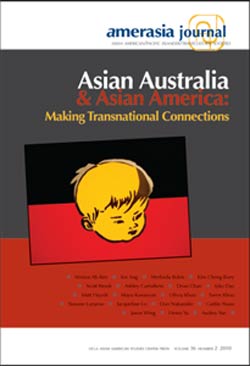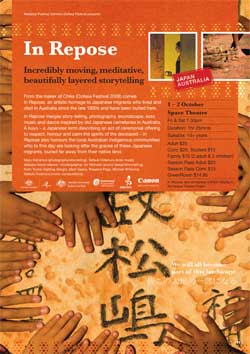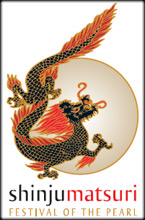 |
 |
In Repose is a site-specific collaborative multi art form project with dance, music, visual projection, sound-scapes and installation, inspired by Japanese graves in Australia from the turn of the century.
In Repose is a requiem: a work of kuyo, a Japanese term, which describes an act of ceremonial prayer or offering to respect, honour and calm the spirits of the deceased. Its origins are in Buddhism, and its practice has become a part of the Japanese spiritual culture with or without its religious connection.
This work began as a process in which the Japanese migrant artists attempted to connect to the land in which they chose to live and die. As the project In Repose takes its shape, this connection has extended beyond the landscape at Belgian Gardens Cemetery in Townsville to the Japanese Cemetery in Broome, families of Broome who still bury their members in this cemetery and to the Japanese Cemetery in Thursday Island.
 |
|
A special issue of Amerasia Journal "Asian Australia, Asian America: Making Transnational Connections" with photo essay by Mayu Kanamori: "Would You Mind If I Settled Here?" was be launched at Museum of Chinese Australian History in Melbourne October 2010
Guest-edited by Jacqueline Lo, Dean Chan and Tseen Khoo
Mayu also spoke on her recent project "In Repose" as part of the Asian Australian Forum
|
|
|
|
|
|
Adelaide Festival Centre's
OzAsia Festival
presents
In Repose
ARTISTS
Mayu Kanamori (photography/storytelling)
Satsuki Odamura (koto music)
Wakako Asano (dance / choreography)
Vic McEwan (sound design/storytelling)
Keith Tucker (lighting design)
Videography: Shigeaki Iwai, Darrin Baker
Music Compositions: Mark Isaacs, Rosalind Page, Michael Whiticker,
Satsuki Odamura
Space Theatre
1 - 2 October
|
 |
|

This project has been assisted by the Australian Government through the Australia Council, its arts funding and advisory body.
|
|
|
STRIPPING BARE…!
2010 ADSA Conference
Australian National University
29th June to 2nd July
KEYNOTE ADDRESS by Dr Jacqueline Lo 'B(e)aring Memory: Invoking the Dead'
with a focus on In Repose

|
|
In Repose 2010
|
IN REPOSE Exhibition & Performative Lecture
Presented by Japan Foundation, Sydney
In Repose photographic exhibition, performances and artist talks were held at Japan Foundation Gallery in April/May 2010
The photographic exhibition consisted of 40 photographs by Mayu Kanamori from Japanese cemeteries around Australia with accompanying sound installation by Vic McEwan. Also exhibited were the four durational works created during their residencies in Townsville, Broome and Thursday Island, including a Townsville video work by Shigeaki Iwai.
The In Repose performances developed for Sydney audiences told the story of the artists’ spiritual journey through time and ceremony with dance by Wakako Asano and koto music by Satsuki Odamura. Through Mayu Kanamori and Vic McEwan's lecture style story-telling, merged with dance, music, images and ceremony, the work challenged contemporary forms of art, performance and its taboos.
Lighting Design: Amber Silk
Reviews:
| Sydney Season 2010 |
| Artists' Performative Lectures: |
10 April, 1 May, 13 May
|
| Artist talk by Mayu Kanamori & Koto performance by Satsuki Odamura: |
|
11 May
|
| Artist Talk with Mayu Kanamori: |
27 April, 11 May
|
| Associated Artists |
Shigeaki Iwai |
Artist's Talk on Radio National
The In Repose artists were featured on ABC Radio National's The Rhythm Divine, Friday 9th, April
|
|
|

Photograph: Mayu Kanamori
Flyer: Sarah Moor
|
In Repose on Thursday Island:
November 2008
Artist Workshops: Gab Titui Cultural Centre
Student Workshops: Tagai State College
Exhibition: Gab Titui Cultural Centre
Performance: Thursday Island Cemetery
Artists
Wakako Asano - Dance / choreography
Mayu Kanamori - Visual art
Vic McEwan - Sound Design
Satsuki Odamura - Sound/Koto music
|
|
Workshops
In Repose artists held two one-day workshops on the island: A story telling workshop with local artists at Gab Titui Cultural Centre and a students' performance workshop at Tagai State College. The participating artists each created their own digital stories with photographs and sound to do with their ideas about death and burial whilst the students wrote poetry and created physical movements from their experiences at the historical Japanese Cemetery on Thursday Island.
Jam Session
Satsuki Odamura held an informal jam session at Gab Titui Cultural centre with local musicians. As a result of this night local artist Frank Moitha David played the traditional Torres Strait warup drums and Tibetan gongs during the site-specific performance held at the Japanese Cemetery with Satsuki Odamura's koto.
A Performance Evening - featuring dance, music and ceremony
On 28 November, In Repose team met with about 100 local people in front of the Japanese monument at the historical cemetery. The evening began with Welcome to Country spoken in language by elder Joseph Wasaga. After which Vic McEwan explained the project to the audience, then Wakako Asano demonstrated the Japanese way of ceremony by giving water and incense to the graves. The audience scattered to all parts of the cemetery with their own water and incense and gave their kuyo until Frank Moitha David and Satsuki Odamura began their improvisational duet, followed by Satsuki's playing of bass koto with Wakako Asano's dance. The evening ended in twilight with one hundred candles lighting the tombs.
Exhibition Videowork - Gab Titui Cultural Centre
Videowork by Vic McEwan (sound) and Mayu Kanamori (image) was created during their two week stay in the Torres Strait, utilising images of the Japanese cemetery, the sea and landscape with sounds of the Torres Strait waters, the cemetery and collected stories from local Islanders Chi Chi Fujii and Bill Shibazaki both who are of Japanese descent.
|
|
|
|
In Repose Broome - As part of Shinju Matsuri Festival 2008
Student Workshops and Performance - 25 August 2008
In Repose series of events in Broome began with site-specific performance workshops with senior performing arts students at St Mary's College. Katy Fitzgerald facilitated the workshop in coordination with teacher Vicki Thompson from St Mary's College with introduction to site-specific art by Vic McEwan, koto introduction and demonstration by Satsuki Odamura, and introduction of Noh by Wakako Asano.
Lead by Wakako, the students visited the Japanese Cemetery. They were divided into groups to begin contemplation on themes such as Land of Broome, Spirits and Ancestors, Family and Friends, and Nature. With these themes and their reflections of the cemetery, Wakako and the students choreographed a dance and wrote poems about their themes, which was integrated with the choreography.
Just before sunset, Satsuki played koto improvisations, her own composition "Hikishio Michishio" and composer Rosalind Page's "Garden," both composed especially for In Repose and the students performed the dance they choreographed that day to an audience of over 150 people. Included in the audience was Mrs Pearl Hamaguchi, whose husband, successful pearling master Mr Hiroshi Hamaguchi is buried in this cemetery, and coincidentally had passed away exactly one year prior to this performance. Rika Hamaguchi, Mr and Mrs Hamaguchi's granddaughter was one of the performers of In Repose Student's Performance.
Performance at Cemetery - 26 August 2008
In Repose' main performance began just before sunset at Broome's Japanese Cemetery with audience of over 120 people walking through the cemetery grounds in quiet contemplation. When the audience gathered to the natural stage area in the middle of the cemetery, Vic introduced Mrs Dorris Edgar and her daughter Mrs Dianne Appleby, who represented the Yawuru People, who are the traditional owners of the land in which the Japanese Cemetery rests. During the Welcome to Country speech by Mrs Edgar, who spoke in her language, later translated by her daughter, said that her grandfather was Japanese and was buried in this cemetery.
After Vic introduced the concepts of In Repose, he asked the audience members to join in our kuyo - a ceremonial offering for the deceased. The audience were given bottles of water and incense, and they scattered a far to all areas of the cemetery to partake in the kuyo. In amongst the audience were Mr Akira Masuda, Mrs Evelyn Masuda and their daughters and grandchildren, who took incense and water to Mr Masuda's brother Takamichi and Mr and Mrs Masuda's son Peter, who are buried in this cemetery.
Satsuki, Katy, Wakako and Mayu Kanamori read out 901 names of the people buried in the cemetery, then Wakako lead with sound of temple gongs and some audience members were given gongs to join in to mark the beginning of dance and music. Satsuki played bass koto improvisations, composer Michael Whitticker's "Haiku" and Mark Isaacs' "Chinkon," both especially composed for In Repose, whilst Wakako danced for the audience and the spirits in repose at Broome's Japanese Cemetery.
Carnival of Nations - 27 August 2008
Carnival of Nations is one of the main Shinju Matsuri Festival events, where performers from diverse cultures that make Broome's multicultural mix showcase their work on an outdoor stage at Broome's Courthouse gardens. Wakako danced to Michael Whitticker's "Haiku" for audience of over 300 people.
In Repose Visual and Sound Installation Opening - Gecko Gallery - 28 August 2008
About 120 people attended the opening of In Repose exhibition at Gecko Gallery in Broome. The work on display was video installation of Mayu's images of Broome's Japanese Cemetery, including those of community members at the cemetery with a journey themed sound design by Vic, which consisted of site-specific sounds of Broome and reading of all 901 names of people buried in the cemetery by Broome's Japanese community elder and former pearl diver Mr Yoshihiro (Nicky) Akune. Also displayed In the gallery was Katy's curated display of Mayu's photography work of the cemetery.
After viewing the installation with wine and finger foods, Satsuki played koto improvisations, Mark Isaacs' "Chinkon" on bass koto and Michael Whitticker's "In Repose" on koto, which included sound scapes of Broome designed by Vic. Wakako danced with Mayu's images of the cemetery projected behind her.
In the audience was Mr Akune, who came to us after the performance, moved by the experience, thanked the In Repose team and said that his predecessors in the graves must be joyous because of what had transpired. He added that he was glad to know that he was not the only one that had been thinking about his "hone o uzumeru kakugo" and become part of the Australian landscape.
|
|
|
 |
 |
 |
|
|
Japanese Graves - Port Hedland, Roebourne and Cossack 2008
After the Broome season of In Repose, the team's dancer and choreographer Wakako Asano, sound designer and production manager Vic McEwan and visual artist and producer Mayu Kanamori travelled south to other destinations of interest -- more Japanese graves.
Vic drove 800kms and the three artists arrived in Port Hedland late in the evening without a hotel booking. After making several enquiries for vacancies in this booming town due to mining, found a motel near the beach. The following morning, to their surprise, the artist found that their motel was right next door to the Japanese section of Port Hedland's Pioneer and Pearlers Cemetery.
Wakako danced a private kuyo performance at the Japanese section of this cemetery with a dozen graves. Afterwards Wakako danced again in another part of the cemetery, apparently an older section, which had half a dozen Japanese graves scattered amongst other Asian graves.
The artists travelled further south down the Warlu (sea serpent) Way to the historical town of Roebourne, established in 1866, and was the administrative capital for the North West of Australia. Using information received from a Japanese expatriate in Perth and former resident of Karratha, Mr Go Morimoto, the artists searched for the dozen or so Japanese graves which were located just outside of the grounds of the Roebourne Cemetery.
As the graves were not easy to find, the artists asked a local woman who was with a group of people playing guitar on the balcony of a nearby house. She happened to be a fellow artist, Loreen Samson, who guides younger artists in her community to make art from their hearts. Loreen told the In Repose artists that the Japanese graves were no longer there and that it had been cleared to make space for new housing beside the cemetery and that she remembers them there as a child. She then said she was sad about it and that "this sort of thing happens to us all the time."
Wakako watered the land around the new housing, lit a few incense and had a prayer for those spirits buried there. Then some boys came from one of the two new houses built on where some of the graves had been -- and asked what Wakako was doing. The artists explained and when they told the boys about people being buried there, they asked, "How do you know?" Vic answered, " Some people who have lived here for a long time remember." They asked about Japan. Vic played a tune on a harmonica, which belonged to one of the boys. Wakako danced a little dance and the boys joined this small ceremonial performance with incense.
In Cossack, a historical port town with a significant pearling history, which preceded that of Broome, is a Japanese Cemetery, restored recently by Mitsui Iron Ore Development. The cemetery is next to a European Cemetery and is located by the sea with eight graves and one memorial tower.
Wakako gave the graves water, incense and prayer, read out the names of all the people buried there and danced a private kayo performance for the spirits.
|
|
The Australian Spirit -- 2007
In Repose premiered as part of National Trust Queensland's Annual Heritage Week Festival in May 2007 with performances by Satsuki Odamura and Wakako Asano
 The In Repose Video Art was exhibited at Umbrella Studio, Townesville in April / May 2007
The In Repose Video Art was exhibited at Umbrella Studio, Townesville in April / May 2007
|
|
Artist's Workshops and Showing, February 2007
Japanese Section, Belgian Gardens Cemetery, Townsville
Just before dusk on 10th February, thirty invited guests arrived at the Belgian Gardens Cemetery to for a sneak preview of site-specific multi art project In Repose, during Townsville's annual Heritage Week in May 2007. Inspired by the remains of Japanese graves in Townsville from the turn of the century, four artists from Sydney and one from Tokyo have been holding workshops on site at the cemetery, and have arranged a private viewing for the local residents.
The guests walked slowly from the entrance of the cemetery to the Japanese section, lead by sound artist and the group's production manager Vic McEwan, who explained the concept of In Repose. Bradley Burrows, the sexton of the Belgian Gardens cemetery also spoke about the history of the cemetery and about some of the other sections within the cemetery. The cemetery is divided in to various Christian denominations as well Chinese, Jewish and other groups.
At the Japanese section, guests were invited to view the remaining Japanese graves. Although this section is large, unlike the other sections in the cemetery, it is sparse and with only twenty remaining tombs, telling of the severed Japanese history in Australia due to WWII. The current Japanese community of thirty residents in Townsville are not related to the graves in Belgian Gardens, and many of them did not know about its existence.
At dusk, with sounds of seventeen stringed bass koto by koto virtuoso Satsuki Odamura, dancer Wakako Asano (Sydney Dance Company) dressed in garment prepared by Sydney based fashion designer Akira Isogawa appeared from behind one of the tomb stones with a bell in her hand, and walked to the scattered tomb stones and acknowledged each of them by the sounding of the bells. Odamura for this occasion played Australian composer Mark Isaacs piece, especially composed for koto and for this project, entitled "Chinkon." Chinkon in Japanese means to quieten the spirits.
Asano danced amongst the old Japanese graves with the natural Australian bushland behind the cemetery and the setting sun behind her,. Odamura's koto was complimented by the sounds of frogs, birds and the wind, adding texture to the meaning this project, initiated by the wish of first generation Japanese migrant artists to make connection with the Australian landscape.
After receiving feedback from the invited guests, the artists are now in the process of refining and reworking the performance, and its corresponding video art. Australian sound artist Vic McEwan, Tokyo based video-installation artist Shigeaki Iwai and Sydney based photographer-video artist Mayu Kanamori will be exhibiting a corresponding collaborative video art work, also entitled In Repose at Umbrella Studio in Townsville also during Heritage Week.
|
|
History Townsville: In 1896, the first Japanese Consulate in Australia opened in Townsville to service the 4000 Japanese who arrived in Queensland to work in the sugar cane, turtle, trochus, beche de mere and pearling industries. Other Japanese followed, and worked as prostitutes, domestic servants, laundry operators, and interpreters.There was a thriving Japanese community once in Townsville, and the first recorded Japanese migrant in Australia settled in Townsville. Due to the White Australia Policy, demand for the Japanese workers ceased in time, and the Consulate closed in 1908. In the Belgian Gardens Cemetery there are still marked and unmarked Japanese graves from this time. In 1942, Townsville was target of Japanese bombing raids.
History Broome and Thursday Island: Both Broome and Thursday Island have a diverse history, one of which is the Pearling Industry. Since the late 1800's, this industry brought to both Broome and Thursday Island many cultures including Japanese divers. As a result of the harsh conditions of diving many Japanese divers perished. There are approximately 700 Japanese graves at Broome Cemetery and 800 graves at Thursday Island Cemetery, both with a large monument to the Japanese divers that died during this time. Both Broome and Thursday Island were targets of Japanese bombing raids in 1942.
|
|